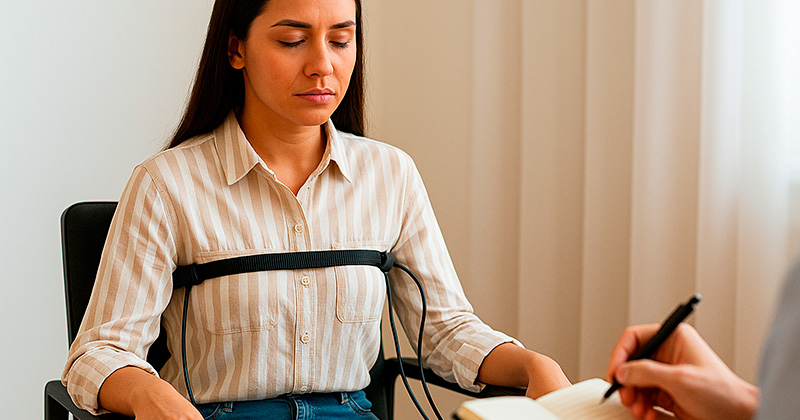Introduction
Antonio and Clara had been married for twelve years. A quiet life, two children, a house in the suburbs, and a routine marked by the absences of Antonio, a long-distance lorry driver. Until a small gesture ignited a great doubt.
During one of those weeks alone, Clara allowed Lucas, a friend of theirs, to stay over after a long conversation. Nothing happened, according to her. But Antonio couldn't help thinking that something else had happened. Doubt settled in like a crack in the trust.
First contact with the case: an interview
They decided to come to me for a polygraph test. First I interviewed Antonio, who, although visibly hurt, insisted that he only wanted to know the truth. Then I spoke to Clara: she was calm, self-assured, and agreed to take the test without hesitation. For both of them, this step was decisive.
This first contact makes it possible to assess the disposition of each party, the emotional context, and to rule out external pressures or previous manipulation.

Questionnaire design: keys and control
Once I understood the emotional background, I proceeded to design the set of questions that would form the test. The protocol calls for alternating key questions with control questionsThe aim is to establish an emotional baseline and detect physiological variations associated with truth or lies.
Control questions
- Have you ever lied to your partner in the past?
- Have you ever had romantic thoughts for someone outside your relationship?
- Have you kept anything important from Antonio?
- Are you absolutely sure that you have never been unfaithful?
These questions serve to measure emotional reactivity in uncomfortable situations, and compare it with reactions to key questions.
Key questions
- Did any inappropriate physical contact occur between you and Lucas?
- Were there any romantic or sexual advances between the two?
- Do you feel guilty about anything related to the night Lucas slept at your house?
- Did you hide anything that happened that day from Antonio?
Each question is asked in different ways in different rounds to ensure consistency in physiological responses.
Polygraph installation and calibration
Clara was the first to undergo the test. Sensors were attached to her torso to record her breathing, a blood pressure cuff on her arm and electrodes on her fingers to measure the galvanic response of her skin. All this makes it possible to observe in real time how her body responds to each verbal stimulus.
Before starting the test, we carried out a round of neutral questions to calibrate the machine:
- Is your name Clara?
- Is today Tuesday?
- Are you sitting down?
These questions help to establish the normal physiological patterns of the person being assessed.

The session: responses between tension and certainty
The test was conducted in several rounds, interspersing the key questions with the control questions. Clara maintained a stable pattern throughout. Her heart rate, blood pressure, sweating and respiratory rate showed no signs of alteration to any of the key questions.
Interestingly, their most tense responses were recorded in one of the control questions: "Have you ever lied to your partner? Common and expected. However, on the questions that really mattered, related to Lucas, his body did not lie.
The result: the truth comes out
The final analysis was conclusive: there was no evidence of cheating. Clara had not had any kind of inappropriate relationship with Lucas. The night he slept at her house was indeed innocent.
When I presented the results to Antonio, he burst into tears. Not out of sadness, but out of relief. Clara, also moved, took his hand. They had come looking for certainties, and they had found them. But the most important thing of all was not the result, but what came after: the mutual commitment to work on trust and to heal what doubt had eroded.
Epilogue
This case reminds us that sometimes the truth doesn't hurt... what hurts is suspicion. And when it is done well, the polygraph can be more than a tool for detecting lies: it can be a gateway to rebuilding broken ties.


